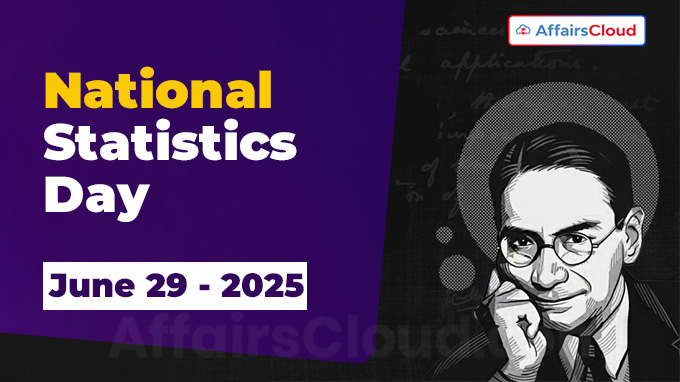 National Statistics Day is annually observed across India on June 29 to honour the contributions of statisticians and highlight the importance of statistics in socio-economic development and policy formulation.
National Statistics Day is annually observed across India on June 29 to honour the contributions of statisticians and highlight the importance of statistics in socio-economic development and policy formulation.
- The day commemorates the birth anniversary of Professor Prasanta Chandra (P.C.) Mahalanobis, who is known as the Father of Modern Statistics in India.
- June 29, 2025, marked the 19th observance of National Statistics Day and the 132nd birth anniversary of P.C. Mahalanobis.
2025 Theme:
The 2025 theme for National Statistics Day is “75 Years of National Sample Survey(NSS)”, celebrating the survey’s major role in supporting data-driven policies over decades.
Note: Established in 1950, the NSS pioneered large-scale sample surveys globally. It collects data on employment, consumption, health, and agriculture, forming the backbone of evidence-based governance in India.
Background:
i.On 5 June 2007, the Government of India (GoI) officially declared 29 June every year as Statistics Day, to be observed as one of the Special Days celebrated at the National Level.
ii.This date was selected to commemorate the birth anniversary of Professor Prasanta Chandra Mahalanobis, honoring his pioneering contributions such as the Mahalanobis Distance metric in statistics and the Feldman-Mahalanobis model used in India’s economic planning.
iii.The first National Statistics Day was observed on 29 June 2007.
About Professor Prasanta Chandra Mahalanobis:
i.P.C. Mahalanobis was born on 29 June 1893 in Calcutta (present-day Kolkata), West Bengal (WB).
ii.He founded the Indian Statistical Institute (ISI) in 1931, which was declared an Institution of National Importance by the Indian Parliament Act 1959.
iii.A Central Statistical Unit was established by GoI in 1949, with P.C. Mahalanobis appointed as the Honorary Statistical Adviser to the Cabinet. He played a pivotal role in formulating India’s strategy for industrialisation under the 2nd Five-Year Plan (1956–1961).
iv.He was honoured with the Padma Vibhushan, India’s second-highest civilian award, in 1968 in the field of Literature and Education. He was appointed as an Officer of the Order of the British Empire (OBE) in 1942, and elected an Honorary Fellow of King’s College, Cambridge in 1959.
v.He passed away on June 28, 1972 in South Calcutta, WB.
2025 Events:
The Ministry of Statistics and Programme Implementation(MoSPI) celebrated the 19th National Statistics Day on 29 June 2025 at the Dr. Ambedkar International Centre, New Delhi (Delhi). The event was inaugurated by Union Minister of State (MoS) (Independent Charge, IC) Rao Inderjit Singh, MoSPI, who participated as the Chief Guest.
- Around 700 participants attended the celebration, including international organizations, state officials, and statisticians.
i.To mark the 75th anniversary of the National Sample Survey (NSS), the MoSPI released both a Rs.75 commemorative coin and a customized postal “My Stamp” .
ii.The occasion featured the conferring of Prof. C.R. Rao National Award for 2025 in Statistics to Dr. Prajamitra Bhuyan, Assistant Professor, Indian Institute of Management (IIM) Calcutta (WB), for his exceptional contributions to the field of statistics.
Several important initiatives and publications were launched on the occasion, including:
1.GoIStats Mobile Application:
The National Sample Survey Office (NSSO) under MoSPI launched the GoIStats mobile application (App) to enhance public access to official statistics. Its feature includes,
- Interactive Key Trends dashboard displaying major socio-economic indicators such as Gross Domestic Product (GDP), inflation, employment.
- One-click downloads of data tables and reports.
- Visual data storytelling through infographics and dynamic charts.
- Comprehensive metadata, mobile-friendly tables, and social sharing options.
2.Publications on Sustainable Development Goals (SDGs):
MoSPI published SDGs – National Indicator Framework Progress Report 2025; Data Snapshot on SDGs – National Indicator Framework, 2025; SDGs National Indicator Framework, 2025; and NSS Report on Nutritional Intake in India 2022-23 & 2023-24 based of Household Consumption Expenditure Survey.
1.Highlights of SDGs-National Indicator Framework Progress Report 2025:
i.Rural drinking water access: Increased to 99.62% (2024–25) from 94.57% (2015–16).
ii.Renewable Energy(RE) capacity: Rose to 156.31 watts per capita (2024–25) from 64.94 watts per capita (2014–15).
iii.Internet subscriptions: Increased to 954.40 million (2024) from 302.36 million (2015).
iv.Social protection coverage: Expanded from 22% (2016) to 64.3% (2025).
v.Start-ups recognised under Start-up India: Grew from 453 (2016) to 34,293 (2024).
vi.Forest cover: Increased from 21.34% (2015) to 21.76% (2023).
vii.The Gross Value Added(GVA) in agriculture per worker has increased from Rs.61,247 in 2015-16 to Rs.94,110 in 2024-25.
- The Gini coefficient for household expenditure in rural areas declined from 0.283 in 2011–12 to 0.237 in 2023–24.
- Similarly, in urban areas, it decreased from 0.363 in 2011–12 to 0.284 in 2023–24.
2.The Data Snapshot on Sustainable Development Goals – National Indicator Framework, Progress Report, 2025 is a concise handbook derived from the comprehensive Sustainable Development Goals – National Indicator Framework Progress Report, 2025. It provides national-level time series data for the SDG indicators.
3.The Sustainable Development Goals – National Indicator Framework, 2025 is also a handbook-format report derived from the same progress report, covering all 284 national SDG indicators along with their data sources and periodicity.
4.The NSS Report on Nutritional Intake in India for 2022–23 and 2023–24, based on the Household Consumption Expenditure Survey (HCES), was released during the 19th National Statistics Day celebrations. This report provides insights into the dietary patterns and nutritional intake of Indian households, highlighting significant trends and shifts over the two-year period.
3.Publication on Agriculture and Allied Sectors:
MoSPI also released the “Statistical Report on Value of Output from Agriculture and Allied Sectors (2011-12 to 2023-24)”, providing detailed estimates for crop, livestock, forestry, and fishing production.
Key Highlights:
i.Gross Value Added (GVA): Rose 225%, from Rs. 1,502 thousand crore to Rs. 4,878 thousand crore (current prices).
ii.Gross Value of Output (GVO): Increased from Rs.1,908 thousand crore in 2011–12 to Rs.2,949 thousand crore in 2023–24, reflecting an overall growth of about 54.6%.
iii.Cereals and fruits & vegetables: Together made up 52.5% of crop GVO.
- Among cereals, paddy and wheat together account for nearly 85% of the GVO at constant prices for the year 2023–24.
iv.Top cereal-producing states: Uttar Pradesh (UP) (17.2%), Madhya Pradesh (MP), Punjab, Telangana, Haryana (53% combined).
v.Banana GVO: Rs. 47 thousand crore (2023–24), surpassing mango at Rs. 46.1 thousand crore.
vi.Potato GVO: Increased from Rs. 21.3 thousand crore (2011–12) to Rs. 37.2 thousand crore (2023–24).
4.Strengthening Digital Transformation:
i.MoSPI has advanced its digital transformation journey by launching the eSankhyiki Portal in 2024, which provides stakeholders with real-time access to India’s official statistics.
ii.Other developments launched include Data Innovation Lab (DI Lab), Online Content Management System (OCMS), Metadata Portals, and dashboards for: Social Statistics Division (SSD), Annual Survey of Industries (ASI), Economic Census (EC), and NSS.
iii.Over 135 million records are now accessible digitally. To secure national data assets, a Chief Information Security Officer (CISO) has been appointed, and an expert agency engaged to strengthen cybersecurity.
About Indian Statistical Institute (ISI):
Chairman – Koppillil Radhakrishnan
Headquarters – Kolkata, West Bengal (WB)
Established – 1931




